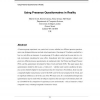Free Online Productivity Tools
i2Speak
i2Symbol
i2OCR
iTex2Img
iWeb2Print
iWeb2Shot
i2Type
iPdf2Split
iPdf2Merge
i2Bopomofo
i2Arabic
i2Style
i2Image
i2PDF
iLatex2Rtf
Sci2ools
PRESENCE
2000
2000
Using Presence Questionnaires in Reality
A between-group experiment was carried out to assess whether two different presence questionnaires can distinguish between real and virtual experiences. One group of 10 subjects searched for a box in a real office environment. A second group of 10 subjects carried out the same task in a virtual environment simulating the same office. Immediately after their experience subjects were given two different presence questionnaires in randomised order: the Witmer and Singer Presence (WS), and the questionnaire developed by Slater, Usoh and Steed (SUS). The paper argues that questionnaires should be able to pass a `reality test'- whereby under current conditions the presence scores should be higher for real experiences than for virtual ones. Nevertheless, there was only a marginally higher mean presence score for the SUS score for the real compared to the virtual, and no significant difference at all in the case of the WS mean score. It is concluded that though such questionnaires may be...
| Added | 19 Dec 2010 |
| Updated | 19 Dec 2010 |
| Type | Journal |
| Year | 2000 |
| Where | PRESENCE |
| Authors | Martin Usoh, Ernest Catena, Sima Arman, Mel Slater |
Comments (0)

